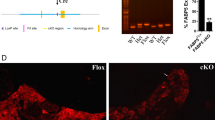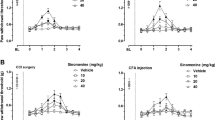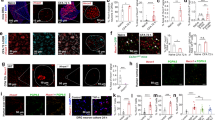Abstract
Inflammatory pain, such as arthritis pain, is a growing health problem1. Inflammatory pain is generally treated with opioids and cyclooxygenase (COX) inhibitors, but both are limited by side effects. Recently, resolvins, a unique family of lipid mediators, including RvE1 and RvD1 derived from omega-3 polyunsaturated fatty acid, have shown marked potency in treating disease conditions associated with inflammation2,3. Here we report that peripheral (intraplantar) or spinal (intrathecal) administration of RvE1 or RvD1 in mice potently reduces inflammatory pain behaviors induced by intraplantar injection of formalin, carrageenan or complete Freund's adjuvant (CFA), without affecting basal pain perception. Intrathecal RvE1 injection also inhibits spontaneous pain and heat and mechanical hypersensitivity evoked by intrathecal capsaicin and tumor necrosis factor-α (TNF-α). RvE1 has anti-inflammatory activity by reducing neutrophil infiltration, paw edema and proinflammatory cytokine expression. RvE1 also abolishes transient receptor potential vanilloid subtype-1 (TRPV1)- and TNF-α–induced excitatory postsynaptic current increases and TNF-α–evoked N-methyl-D-aspartic acid (NMDA) receptor hyperactivity in spinal dorsal horn neurons via inhibition of the extracellular signal–regulated kinase (ERK) signaling pathway. Thus, we show a previously unknown role for resolvins in normalizing the spinal synaptic plasticity that has been implicated in generating pain hypersensitivity. Given the potency of resolvins and the well-known side effects of opioids and COX inhibitors, resolvins may represent new analgesics for treating inflammatory pain.
This is a preview of subscription content, access via your institution
Access options
Subscribe to this journal
Receive 12 print issues and online access
$209.00 per year
only $17.42 per issue
Buy this article
- Purchase on Springer Link
- Instant access to full article PDF
Prices may be subject to local taxes which are calculated during checkout




Similar content being viewed by others
References
Schnitzer, T.J. Update on guidelines for the treatment of chronic musculoskeletal pain. Clin. Rheumatol. 25 Suppl 1, S22–S29 (2006).
Serhan, C.N., Chiang, N. & Van Dyke, T.E. Resolving inflammation: dual anti-inflammatory and pro-resolution lipid mediators. Nat. Rev. Immunol. 8, 349–361 (2008).
Connor, K.M. et al. Increased dietary intake of omega-3-polyunsaturated fatty acids reduces pathological retinal angiogenesis. Nat. Med. 13, 868–873 (2007).
Gilroy, D.W. et al. Inducible cyclooxygenase may have anti-inflammatory properties. Nat. Med. 5, 698–701 (1999).
Schwab, J.M., Chiang, N., Arita, M. & Serhan, C.N. Resolvin E1 and protectin D1 activate inflammation-resolution programmes. Nature 447, 869–874 (2007).
Chiang, N. et al. Anesthetics impact the resolution of inflammation. PLoS One 3, e1879 (2008).
Haworth, O., Cernadas, M., Yang, R., Serhan, C.N. & Levy, B.D. Resolvin E1 regulates interleukin 23, interferon-γ and lipoxin A4 to promote the resolution of allergic airway inflammation. Nat. Immunol. 9, 873–879 (2008).
Julius, D. & Basbaum, A.I. Molecular mechanisms of nociception. Nature 413, 203–210 (2001).
Hucho, T. & Levine, J.D. Signaling pathways in sensitization: toward a nociceptor cell biology. Neuron 55, 365–376 (2007).
Woolf, C.J. & Salter, M.W. Neuronal plasticity: increasing the gain in pain. Science 288, 1765–1769 (2000).
Ji, R.R., Kohno, T., Moore, K.A. & Woolf, C.J. Central sensitization and LTP: do pain and memory share similar mechanisms? Trends Neurosci. 26, 696–705 (2003).
Yamamoto, T. & Yaksh, T.L. Comparison of the antinociceptive effects of pre- and posttreatment with intrathecal morphine and MK801, an NMDA antagonist, on the formalin test in the rat. Anesthesiology 77, 757–763 (1992).
Ji, R.R., Baba, H., Brenner, G.J. & Woolf, C.J. Nociceptive-specific activation of ERK in spinal neurons contributes to pain hypersensitivity. Nat. Neurosci. 2, 1114–1119 (1999).
Yaksh, T.L. Spinal systems and pain processing: development of novel analgesic drugs with mechanistically defined models. Trends Pharmacol. Sci. 20, 329–337 (1999).
Kawasaki, Y. et al. Distinct roles of matrix metalloproteases in the early- and late-phase development of neuropathic pain. Nat. Med. 14, 331–336 (2008).
Arita, M. et al. Stereochemical assignment, antiinflammatory properties, and receptor for the omega-3 lipid mediator resolvin E1. J. Exp. Med. 201, 713–722 (2005).
Cash, J.L. et al. Synthetic chemerin-derived peptides suppress inflammation through ChemR23. J. Exp. Med. 205, 767–775 (2008).
Wittamer, V. et al. Specific recruitment of antigen-presenting cells by chemerin, a novel processed ligand from human inflammatory fluids. J. Exp. Med. 198, 977–985 (2003).
Liu, X.J. et al. Treatment of inflammatory and neuropathic pain by uncoupling Src from the NMDA receptor complex. Nat. Med. 14, 1325–1332 (2008).
Goldberg, R.J. & Katz, J. A meta-analysis of the analgesic effects of omega-3 polyunsaturated fatty acid supplementation for inflammatory joint pain. Pain 129, 210–223 (2007).
Arita, M. et al. Metabolic inactivation of resolvin E1 and stabilization of its anti-inflammatory actions. J. Biol. Chem. 281, 22847–22854 (2006).
Schäfers, M., Svensson, C.I., Sommer, C. & Sorkin, L.S. Tumor necrosis factor-α induces mechanical allodynia after spinal nerve ligation by activation of p38 MAPK in primary sensory neurons. J. Neurosci. 23, 2517–2521 (2003).
Junger, H. & Sorkin, L.S. Nociceptive and inflammatory effects of subcutaneous TNFα. Pain 85, 145–151 (2000).
Kawasaki, Y., Zhang, L., Cheng, J.K. & Ji, R.R. Cytokine mechanisms of central sensitization: distinct and overlapping role of interleukin-1β, interleukin-6, and tumor necrosis factor-α in regulating synaptic and neuronal activity in the superficial spinal cord. J. Neurosci. 28, 5189–5194 (2008).
Caterina, M.J. et al. Impaired nociception and pain sensation in mice lacking the capsaicin receptor. Science 288, 306–313 (2000).
Nicol, G.D., Lopshire, J.C. & Pafford, C.M. Tumor necrosis factor enhances the capsaicin sensitivity of rat sensory neurons. J. Neurosci. 17, 975–982 (1997).
Jin, X. & Gereau, R.W. Acute p38-mediated modulation of tetrodotoxin-resistant sodium channels in mouse sensory neurons by tumor necrosis factor-α. J. Neurosci. 26, 246–255 (2006).
Zhuang, Z.Y., Xu, H., Clapham, D.E. & Ji, R.R. Phosphatidylinositol 3-kinase activates ERK in primary sensory neurons and mediates inflammatory heat hyperalgesia through TRPV1 sensitization. J. Neurosci. 24, 8300–8309 (2004).
Vara, H., Onofri, F., Benfenati, F., Sassoe-Pognetto, M. & Giustetto, M. ERK activation in axonal varicosities modulates presynaptic plasticity in the CA3 region of the hippocampus through synapsin I. Proc. Natl. Acad. Sci. USA 106, 9872–9877 (2009).
Karim, F., Wang, C.C. & Gereau, R.W. Metabotropic glutamate receptor subtypes 1 and 5 are activators of extracellular signal–regulated kinase signaling required for inflammatory pain in mice. J. Neurosci. 21, 3771–3779 (2001).
Samad, T.A. et al. Interleukin-1β–mediated induction of Cox-2 in the CNS contributes to inflammatory pain hypersensitivity. Nature 410, 471–475 (2001).
Woolf, C.J. μ and δ opioid receptors diverge. Cell 137, 987–988 (2009).
Porreca, F. & Ossipov, M.H. Nausea and vomiting side effects with opioid analgesics during treatment of chronic pain: mechanisms, implications and management options. Pain Med. 10, 654–662 (2009).
Funk, C.D. & FitzGerald, G.A. COX-2 inhibitors and cardiovascular risk. J. Cardiovasc. Pharmacol. 50, 470–479 (2007).
Gavva, N.R. Body-temperature maintenance as the predominant function of the vanilloid receptor TRPV1. Trends Pharmacol. Sci. 29, 550–557 (2008).
Brennan, T.J., Vandermeulen, E.P. & Gebhart, G.F. Characterization of a rat model of incisional pain. Pain 64, 493–501 (1996).
Kim, S.H. & Chung, J.M. An experimental model for peripheral neuropathy produced by segmental spinal nerve ligation in the rat. Pain 50, 355–363 (1992).
Hylden, J.L. & Wilcox, G.L. Intrathecal morphine in mice: a new technique. Eur. J. Pharmacol. 67, 313–316 (1980).
Gao, Y.J. et al. JNK-induced MCP-1 production in spinal cord astrocytes contributes to central sensitization and neuropathic pain. J. Neurosci. 29, 4096–4108 (2009).
Dixon, W.J. Efficient analysis of experimental observations. Annu. Rev. Pharmacol. Toxicol. 20, 441–462 (1980).
Acknowledgements
This work was supported in part by US National Institutes of Health grants R01-DE17794 and R01-NS54362 to R.-R.J., R37 GM38765, R01-DE019938 and R01-DK074448 to C.N.S. and NS67686 to both R.-R.J. and C.N.S.
Author information
Authors and Affiliations
Contributions
R.-R.J. and C.N.S. formulated the hypotheses, designed and supervised the project and prepared the manuscript; R.-R.J. designed most experiments; Z.-Z.X., T.L. and J.Y.P. conducted behavioral studies; L.Z. performed electrophysiological studies; Z.-Z.X. and L.Z. performed immunohistochemistry; Z.-Z.X. performed siRNA-mediated knockdown, cytokine arrays and western blotting; T.B. performed in situ hybridization; R.Y. prepared resolvins and their analogs.
Corresponding authors
Ethics declarations
Competing interests
Resolvins are biotemplates for stable analogs. Patents on these are awarded and assigned to the Brigham and Women's Hospital, and C.N.S. is the inventor. These patents are licensed for clinical development.
Supplementary information
Supplementary Text and Figures
Supplementary Figures 1–7 and Supplementary Methods (PDF 810 kb)
Rights and permissions
About this article
Cite this article
Xu, ZZ., Zhang, L., Liu, T. et al. Resolvins RvE1 and RvD1 attenuate inflammatory pain via central and peripheral actions. Nat Med 16, 592–597 (2010). https://doi.org/10.1038/nm.2123
Received:
Accepted:
Published:
Issue Date:
DOI: https://doi.org/10.1038/nm.2123



